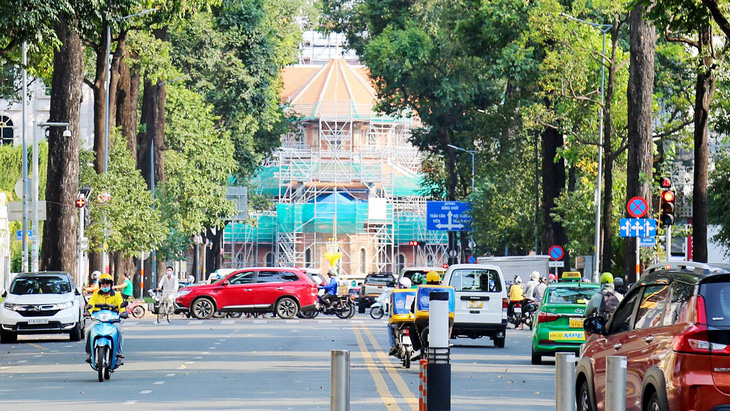Many residents and experts have had high hopes for Ho Chi Minh City’s project to develop a 'super walking area' on 221 hectares of land in the downtown area.
They said that the super walking area should facilitate local residents' life and feature highlights.
Huynh Thi My Chi, a local resident, said the city has had many public destinations for local residents.
“My friends and I visited the Bach Dang Wharf in District 1 on an afternoon, then reached Ho Con Rua [Turtle Lake] in District 3," Chi recounted.
They traveled by public bicycle to experience the service and have a look at landscapes in the downtown area.
“If the city organizes a 'super walking area' with each street featuring a characteristic, the area will become attractive," Chi said.
"However, the walking area should have public transport means, such as bicycles and mini buses, to facilitate locals’ travel.
“I hope each pedestrian street will feature a characteristic, such as books, food, and history.
"If the super walking area is purely an area for walking, it will be incomplete and boring."
Dr. Tran Quang Thang, director of the Institute for Research and Economic Management of Ho Chi Minh City, threw his support behind the project, saying it would help develop a civilized and modern city.
The project would also be a solution to reduce private vehicles entering the downtown area during rush hours, thus easing traffic congestion, Thang added.
Ho Chi Minh City currently has Nguyen Hue and Bui Vien walking streets in District 1, a pedestrian area in the Ho Con Rua (Turtle Lake) area in District 3, and another in District 10.
According to the District 3 People’s Committee, the super walking area would open from 6:00 pm to 10:00 pm on Saturdays and Sundays in the first half of this year.
The area is meant to feature a topic per month, besides food festivals, exhibitions, and a book space.
With the experience in building, operating, and managing these walking streets, the city should develop the super walking area in a way that matches the reality and locals’ demand and would not affect traffic flows.
According to Associate Professor Dr. Vu Anh Tuan, who is in charge of the super walking area project proposed by Urban and Transport Traffic Consulting Co. Ltd., walking street models in other countries bring huge economic, cultural, and traffic benefits.
In Ho Chi Minh City, the world-class super walking area, once completed, will offer a special destination for visitors.
The city can connect it with surrounding public transport to develop residents’ habit of walking and using public vehicles.
The super walking area will be built in the city’s downtown area as the streets there are developed in a grid system, the demand for walking of local residents is high, and the connectivity with bus stops and metro stations is favorable, Tuan shared.
“The super walking area project was formulated on the basis of the local demand and similar models in the world, attaching much importance to traffic and the economy," he said.
“The project will be executed in phases and connected to the two current walking streets, Nguyen Hue and Bui Vien, to form a bustling walking area network in the inner city to serve local residents and tourists.
"There will be seven areas featuring culture, food, and shopping, among others.”
Tuan said the organization of walking streets will be associated with the traffic regulation to facilitate residents' life and the public transport development while shrinking personal vehicles by connecting the walking area with bus, water bus, public bicycle, and metro services.
In addition, the project developer will take advantage of part of the roadways and sidewalks to develop parking lots to generate revenue and deal with the shortage of parking spaces in the city’s inlying area.
Like us on Facebook or follow us on Twitter to get the latest news about Vietnam!





















































